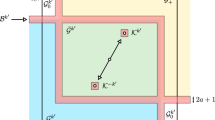Abstract
We prove ergodicity of the finite dimensional approximations of the three dimensional Navier–Stokes equations, driven by a random force. The forcing noise acts only on a few modes and some algebraic conditions on the forced modes are found that imply the ergodicity. The convergence rate to the unique invariant measure is shown to be exponential.
Similar content being viewed by others
REFERENCES
P. Constantin, C. Foias, and R. Temam, On the large time Galerkin approximation of the Navier-Stokes equations, SIAM J. Numer. Anal. 21:615–634 (1984).
G. Da Prato and J. Zabczyk, Ergodicity for infinite-dimensional systems, in London Mathematical Society Lecture Note Series, Vol. 229 (Cambridge University Press, Cambridge, 1996).
W. E and J. C. Mattingly, Ergodicity for the Navier-Stokes equation with degenerate random forcing: finite-dimensional approximation, Comm. Pure Appl. Math. 54: 1386–1402 (2001).
J. P. Eckmann and M. Hairer, Uniqueness of the invariant measure for a stochastic PDE driven by degenerate noise, Comm. Math. Phys. 219:523–565 (2001).
F. Flandoli, Irreducibility of the 3-D stochastic Navier-Stokes equation, J. Funct. Anal. 149:160–177 (1997).
G. Gallavotti, Foundations of Fluid Dynamics, translated from the Italian, Texts and Monographs in Physics (Springer-Verlag, Berlin, 2002).
M. Hairer, Exponential mixing for a stochastic partial differential equation driven by degenerate noise, Nonlinearity 15:271–279 (2002).
N. Jacobson, Basic Algebra I, Second Ed. (W. H. Freeman and Company, New York, 1989).
V. Jurdjevic, Geometric Control Theory, Cambridge Studies in Advanced Mathematics, Vol. 51 (Cambridge University Press, Cambridge, 1997).
V. Jurdjevic and I. Kupka, Polynomial control systems, Math. Ann. 272:361–368 (1985).
S. P. Meyn and R. L. Tweedie, Markov Chains and Stochastic Stability, Communications and Control Engineering Series (Springer-Verlag London, Ltd., London, 1993).
S. P. Meyn and R. L. Tweedie, Stability of Markovian processes. II. Continuous-time processes and sampled chains, Adv. in Appl. Probab. 25:487–517 (1993).
S. P. Meyn and R. L. Tweedie, Stability of Markovian processes. III. Foster-Lyapunov criteria for continuous-time processes, Adv. in Appl. Probab. 25:518–548 (1993).
L. Rey-Bellet and L. E. Thomas, Exponential convergence to non-equilibrium stationary states in classical statistical mechanics, Comm. Math. Phys. 225:305–329 (2002).
D. W. Stroock, Some Applications of Stochastic Calculus to Partial Differential Equations, Eleventh Saint Flour probability summer school—1981 (Saint Flour, 1981), Lecture Notes in Math., Vol. 976 (Springer, Berlin, 1983), pp. 267–382.
D. W. Stroock and S. R. S. Varadhan, On the Support of Diffusion Processes with Applications to the Strong Maximum Principle, Proceedings of the Sixth Berkeley Symposium on Mathematical Statistics and Probability (University California, Berkeley, California, 1970/1971), Vol. III: Probability theory (University California Press, Berkeley, California, 1972), pp. 333–359.
Author information
Authors and Affiliations
Rights and permissions
About this article
Cite this article
Romito, M. Ergodicity of the Finite Dimensional Approximation of the 3D Navier–Stokes Equations Forced by a Degenerate Noise. Journal of Statistical Physics 114, 155–177 (2004). https://doi.org/10.1023/B:JOSS.0000003108.92097.5c
Issue Date:
DOI: https://doi.org/10.1023/B:JOSS.0000003108.92097.5c



